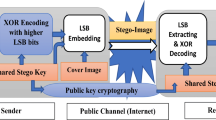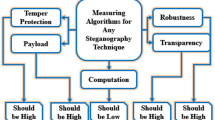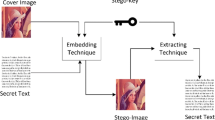Abstract
Transform domain steganography methods are always preferable than spatial domain methods to the research community due to following advantages: better feature identification, improved security and higher robustness. In this paper, an integer sequence named Catalan Transform (CT) has been exploited in the image steganography domain. At the outset, the cover image is decomposed into 2 × 2 non-overlapping blocks in row major order. Then, each such block i.e., 4-pixel group is converted into transform domain using CT. Secret bits are embedded into the transformed components in varying proportions which facilitates us to achieve a payload in the range of 1 to 4 bpp. Inverse Catalan Transform (ICT) is applied over transformed cum embedded quadruples to generate the stego-pixels in spatial domain. Successive embedding operation over an entire image ensures the formation of stego-image. Experimental results confirm that the Peak Signal to Noise Ratio (PSNR) values obtained by the proposed method are always above the acceptable level (i.e., 30 dB) and at the same time, it outperforms many state-of-the-art methods. Other metrics such as Mean Squared Error (MSE), Structural Similarity Index Measure (SSIM), Normalized Cross Correlation (NCC) and Global histograms with similarity measure have also been computed which prove the effectiveness of the proposed scheme. The robustness of the stego-images has further been tested using the StegExpose tool and it is found that the tool is unable to detect the presence of secret data. The code of this work is available at: https://github.com/Souradeep150/Catalan-based-Steganography.





Similar content being viewed by others
References
Abdulla AA (2015) Exploiting similarities between secret and cover images for improved embedding efficiency and security in digital steganography. Doctoral thesis, University of Buckingham, URI:http://bear.buckingham.ac.uk/id/eprint/149
Abdulla AA, Sellahewa H, Jassim SA (2014) Steganography based on pixel intensity value decomposition, Proc. SPIE 9120, Mobile Multimedia/Image Processing, Security, and Applications, https://doi.org/10.1117/12.2050518
Abdulla AA, Sellahewa H, Jassim SA (2019) Improving embedding efficiency for digital steganography by exploiting similarities between secret and cover images. Multimed Tools Appl 8:17799–17823
Akhtar N, Ahamad V, Javed H (2017), A compressed LSB steganography method, Proceedings of 3rd International Conference on Computational Intelligence & Communication Technology (CICT), 1–7, doi: https://doi.org/10.1109/CIACT.2017.7977371, Ghaziabad
Alafandy KA, El-Rabaie E-SM, Faragallah OS, Elmahalawy A (2016) High security data hiding using image cropping and LSB least significant bit steganography, in IEEE, Tangier, Morocco
Al-Dmour H, Al-Ani A (2016) A steganography embedding method based on edge identification and XOR coding. Expert Syst Appl 46:293–306
Al-Jarrah M (2018) RGB-BMP Steganalysis Dataset, Mendeley Data, version 1, https://doi.org/10.17632/sp4g8h7v8k.1, (accessed on 14th January, 2020)
Atawneh S, Almomani A, Al HB, Sumari P, Gupta B (2017) Secure and imperceptible digital image steganographic algorithm based on diamond encoding in DWT domain. Multimed Tools Appl 76:18451–18472
Bánoci V, Bugár G, Levický D (2011) A novel method of image steganography in DWT domain, Proceedings of 21st International Conference Radioelektronika 2011, Brno :1–4, doi: https://doi.org/10.1109/RADIOELEK.2011.5936455
Barry P (2005) A Catalan Transform and Related Transformations on Integer Sequences. J Integer Sequences 8:1–24
Biswas R, Mukherjee S, Bandyopadhyay SK (2013) DCT Domain Encryption in LSB Steganography, in Proceedings of 5th International Conference and Computational Intelligence and Communication Networks, Mathura, India
Boehm B (2014) StegExpose - A Tool for Detecting LSB Steganography, Multimed ,Cryptography Secur,1–11
Dumitrescu S, Wu X, Memon N (2002) On steganalysis of random LSB embedding in continuous-tone images. Proceedings of International Conference on Image Processing, IEEE 3:641–644
Dumitrescu S, Wu X, Wang Z (2003) Detection of LSB steganography via sample pair analysis. IEEE Trans Signal Process 51:1995–2007
Emam MM, Aly AA, Omara FA (2016) An Improved Image Steganography Method Based on LSB Technique with Random Pixel Selection. Int J Adv Comput Sci Appl(IJACSA) 7:361–366
Gadekallu TR, Khare N, Bhattacharya S et al. (2020) Deep neural networks to predict diabetic retinopathy. J Ambient Intell Human Comput. https://doi.org/10.1007/s12652-020-01963-7
Gashkov SB (2015) Arithmetic complexity of certain linear transformations. Mathematical Notes 97:531–555
Ghosal SK, Mandal JK (2013) Stirling Transform based Color Image Authentication. Procedia Technol 10:95–104
Ghosal SK, Mukhopadhyay S, Hossain S, Sarkar R (2020) Application of Lah transform for security and privacy of data through information hiding in telecommunication. Trans Emerging Tel Tech, Wiley :1–20. https://doi.org/10.1002/ett.3984
Golijan M, Rui D (2001) Detecting LSB steganography in color, and gray-scale images. MultimedIEEE 8:22–28
Hajizadeh H, Ayatollahi A , Mirzakuchaki S (2013) A new high capacity and EMD-based image steganography scheme in spatial domain, in 2013 21st Iranian Conference on Electrical Engineering (ICEE), Mashhad, Iran
Hua Zhang LH (2019) A data hiding scheme based on multidirectional line encoding and integer wavelet transform. Signal Process: Image Commun 78:331–344
Jothy N, Anusuyya S (2016) A Secure Color Image Steganography Using Integer Wavelet Transform. 10th International Conference on Intelligent Systems and Control (ISCO)., Coimbatore, India. https://doi.org/10.1109/ISCO.2016.7726948
Kalita M, Tuithung T, Majumder S (2019) A New Steganography Method Using Integer Wavelet Transform and Least Significant Bit Substitution. Comput J 62:1639–1655. https://doi.org/10.1093/comjnl/bxz014
Kamya S (2020) Watermark DCT , MATLAB Central File Exchange. Retrieved July 25, 2020. (https://www.mathworks.com/matlabcentral/fileexchange/46866-watermark-dct)
Kang Y, Liu F, Yang C, Xiang L, Luo X, Wang P (2019) Color image steganalysis based on channel gradient correlation, Int J Distributed Sens Netw., 15
Kim C, Shin D , Shin D , Zhang X (2011) Improved Steganographic Embedding Exploiting Modification Direction in Multimedia Communications, in FTRA International Conference on Secure and Trust Computing, Data Management, and Application
Kuo W-C (2013) A Data Hiding Scheme Based on Square Formula Fully Exploiting Modification Directions. Smart Innov Syst Technol 21:131–139. https://doi.org/10.1007/978-3-642-35473-1_14
Lai C-C, Tsai C-C (2010) Digital Image Watermarking Using Discrete Wavelet Transform and Singular Value Decomposition. IEEE Trans Inst Measurement 59:3060–3063
Mandal JK, Ghosal SK (2014) Binomial Transform Based Fragile Watermarking for image Authentication. J Inf Secur Appl 19:272–281
Mandal JK, Ghosal S (2014) Color image authentication based on two-dimensional separable discrete hartley transform. Adv Modelling Analysis B 57:68–87
Mandal JK, Ghosal SK (2018) On the use of stirling transform in image Steganography. J inf Secur appl 46. https://doi.org/10.1016/j.jisa.2018.04.003
Meng R, Rice SG, Wang J, Sun X (2018) A fusion steganographic algorithm based on faster R-CNN. Comput Materials Continua 55:1–16
Nazari M, Ahmadi ID (2020) A novel chaotic steganography method with three approaches for color and grayscale images based on FIS and DCT with flexible capacity. Multimed Tools Appl 79:13693–13724. https://doi.org/10.1007/s11042-019-08415-1
Peng F, Zhou DL, Long M, Sun XM (2017) Discrimination of natural images and computer generated graphics based on multi-fractal and regression analysis. AEU-International Journal of Electronics and Communications 71:72–81
Poljicak A, Mandic L, Agic D (2011) Discrete Fourier transform-based watermarking method with an optimal implementation radius. J Electron Imaging 20
Raja KB, Reddy HSM (2011) Wavelet based Non LSB Steganography. Int J Adv Netw Appl 03:1203–1209
Randa Atta MG (2018) A High Payload Steganography Mechanism Based on Wavelet Packet Transformation. J Vis Commun Image R 53:42–54
Sathish Shet K, Aswath AR, Hanumantharaju MC, Gao X-Z (2019) Novel high-speed reconfigurable FPGA architectures for EMD-based image steganography. Multimed Tools Appl volume,Springer 78:18309–18338
Seyyedi SA, Ivanov N (2014) High Payload and secure image steganography method based on block partioning and integer wavelet transform. Int J Secur Appl 8:183–194
Shin N (1999) One-Time Hash Steganography. In: Pfitzmann A. (eds) Information Hiding. IH . Lecture Notes in Computer Science,Springer, Berlin, Heidelberg, 1768
Stanley CA (2005) Pairs of values and the Chi-Squared Attack, Department of Mathematics, Iowa State University, CiteSteer,1–45
Wang C-C, Kuo W-C, Huang Y-C, Wuu L-C (2017) A high capacity data hiding scheme based on re-adjusted GEMD. Multimed Tools Appl, 77:6327–6341
Weber AG (2019) USC-SIPI Image Database: Version 5, Original release: October 1997, Signal and Image Processing Institute, University of Southern California, Department of Electrical Engineering. http://sipi.usc.edu/database/ (accessed on 23rd September, 2019)
Xiang L, Wang X, Yang C, Liu P (2017) A Novel Linguistic Steganography Based on Synonym Run-Length Encoding. IEICE Transactions on Information and Systems.,E100.D:313–322
Zhang X, Peng F, Long M (2018) Robust Coverless Image Steganography Based on DCT and LDA Topic Classification. IEEE Trans Multimed 20:3223–3238
Author information
Authors and Affiliations
Corresponding author
Additional information
Publisher’s note
Springer Nature remains neutral with regard to jurisdictional claims in published maps and institutional affiliations.
Rights and permissions
About this article
Cite this article
Mukhopadhyay, S., Hossain, S., Ghosal, S.K. et al. Secured image steganography based on Catalan transform. Multimed Tools Appl 80, 14495–14520 (2021). https://doi.org/10.1007/s11042-020-10424-4
Received:
Revised:
Accepted:
Published:
Issue Date:
DOI: https://doi.org/10.1007/s11042-020-10424-4




